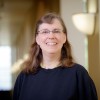This article is more than 5 years old.
This year’s meeting of the Southeast Music Library Association was hosted by Louisiana State University, in Baton Rouge. It was one of those enjoyable meetings where one can just sit back and absorb a lot of new information on a novel topic — this year’s theme was electronic and experimental music. LSU has a large program in this field, and boasts a Laptop Orchestra and a Mobile Device Orchestra. But it’s an area that many of the rest of us don’t have much occasion to deal with.
Some challenges in preserving and distributing born-digital musical works:
- How do you define a musical instrument these days? Especially when the “instrument” is a piece of software or a smartphone? Or is part of a multi-media work?
- How do you distribute such instruments, so that others are able to perform your work?
- How do you notate this kind of music?
- Obsolescence of software and hardware.
Attempted solutions have included:
- Distributing the software for building instruments via websites, and by developing universal encoding standards.
- Archives and repositories for software and media.
- Rapid prototyping of instruments, for instance by producing stand-alone units (containing sensors, circuit boards, etc.) for specific projects.
Other presenters tackled the issues involved in cataloging experimental music. A colleague from Florida State identified lacunae in Library of Congress subject headings: often, the scope is either too broad (“Computer music,” “Electronic music”) or too narrow (flash-in-the-pan trends). There’s a paucity of headings for non-traditional methods of sound production, and extended techniques on instruments (we have “Prepared piano” dating from the 1960s generation, but not for current techniques like fluteboxing.) Another problem: genre and form have traditionally been the primary organizing principle when classifying music, but with much new music it’s the process of creating or performing the work (often on a random or extra-musical basis, as when sensors are placed or mapped so as to produce musical tones when people pass through a public place, or interact with a website) that is the principle aspect. A possible solution to all this: tagging, a.k.a. folksonomies. Some tags assigned by users of Last.fm, for instance, show potential to be incorporated into library catalogs, and into the LCSH hierarchy. A colleage from Chapel Hill also opened fascinating vistas for exploiting linked data in cataloging Hip Hop music: Hip Hop uses sampling from many other genres, so metadata that links to the source recordings would be of inestimable value for academic study, and for the DJs and artists who are currently involved in the identification and preservation of the source material (like Ninth Wonder, who recently guest-lectured at WFU).
On the IL front, presenters from Loyola described how, in response to an accreditation report that revealed deficiencies in the Music School’s efforts to equip its majors with technology skills, they developed a “Tech for Music” course, required for all music students. The course includes sessions on recording techniques, working with images (Photoshop etc.), software for music notation, and web presence for composers and performers, as well as good old library research skills.
All told, interesting sessions and perfect fall weather — couldn’t be better!

5 Comments on ‘Leslie at SEMLA 2014’
Glad that you enjoyed it and found it useful, Leslie!
Fascinating! Thank you for telling us about it. And I love the idea of “sensors … placed or mapped so as to produce musical tones when people pass through a public place.”
Derrik
Thanks for sharing Leslie.
On the “how to define musical instruments these days”, that is a struggle. Not only in electronica, but even beer bottles (https://www.youtube.com/watch?v=3Tv0RNdVKKI). How do you even write music for that?
Thanks Leslie. This is so interesting.